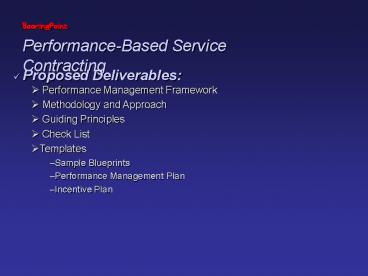PerformanceBased Service Contracting - PowerPoint PPT Presentation
1 / 12
Title:
PerformanceBased Service Contracting
Description:
Templates. Sample Blueprints ... Letters of appreciation to individual employees may translate to bonuses ... This is recommendation number one of six: ... – PowerPoint PPT presentation
Number of Views:50
Avg rating:3.0/5.0
Title: PerformanceBased Service Contracting
1
BearingPoint
Performance-Based Service Contracting
- Proposed Deliverables
- Performance Management Framework
- Methodology and Approach
- Guiding Principles
- Check List
- Templates
- Sample Blueprints
- Performance Management Plan
- Incentive Plan
2
Best Practices As an example - NASA
- Use incentives to motivate contractor performance
- Award term
- Measurable, outcome-based award fee
- Establish teaming arrangement with the contractor
- Use partnering
- Establish common and organization specific goals
- Update Quality Control, Quality Assurance
programs - Require contractor QC program (I.e., ISO 9000)
- Re-evaluate existing government QA program
- Use predictive technologies
- Evaluate contractor processes vs. detailed
inspections - Use outcome-based metrics to gauge contractor
success
3
Whats Industry Doing?
- DOD increasing reliance on PBCs see policy and
guidelines at (http//www.abm.rda.hq.navy.mil/navy
aos/content/view/full/139) - Air Force utilizes PBC see market research web
site at http//www.afcesa.af.mil/search/index.asp - Navy launching full scale effort to overhaul
Facility Service Contracting - Private sector uses PBC, usually with preferred
vendor in long term relationships
4
Monetary Incentives
- Fixed-price contracts, by their nature, include
positive monetary incentives. If it costs the
contractor less to perform, his profit margin
goes up. A negative incentive can also be
included in case the desired results are not
achieved (deduction should be equal to the value
of the service lost). - Cost-plus-incentive-fee (CPIF) or
fixed-price-incentive-fee (FPIF) contracts can be
used when there is some latitude in achieving the
desired results. The ability to succeed or fail
is controlled by the Contractor the Governments
ability to influence contractor performance is
limited to specific areas. - CPIF with multiple incentives contracts include
setting a target cost, along with minimum and
maximum values for cost, fee, technical
performance, and schedule. Funds available for
fees are divided into pools so that there is no
overlap.
5
Monetary Incentives (Continued)
- Cost-plus-award-fee (CPAF) and fixed-price-award-f
ee (FPAF) contracts are used when a mechanism to
motivate a contractor is desired, but performance
cannot be measured objectively or where the
Governments performance objectives can only be
stated in general terms. Both types require an
award-fee plan as a part of the contract.
Incremental adjustments to the criteria in work
authorizations can be made. - Share-in-savings.
6
Non-Monetary Incentives
- Revised schedule
- Reduced oversight
- Positive performance evaluation
- Automatic extension of contract term or option
exercise (FAR Part 17 still applies) - More frequent payments
- Lengthened contract term (award term contracting)
or purchase of extra items (award purchase) - Publish article(s) in agency newsletter or speak
at agency seminars - Letters of appreciation to individual employees
may translate to bonuses - Use trade space for licensing, access to agency
officials, etc. - Use those FAR clauses that can be negotiated to
your advantage
7
Development of practical, meaningful, and
measurable metrics improves the PBC process for
the Government and its Contractors.
- Develop metrics definitions based on industry
best practices with performance target ranges
based on historical averages - Include business impact measures as well as
operations measures - Quantifiable and verifiable metrics ensure the
quality of the measurements - Dont raise the bar higher then a level which we
can perform
8
Minimum Suggested Government Requirementsfor a
Public Sector Solicitation
- Performance requirements that define the work in
measurable, missionrelated terms. - Performance standards (i.e., quality, quantity,
timeliness) tied to the performance requirements. - Government quality assurance (QA) plan that
describes how the contractor's performance will
be measured against the performance standards. - If the acquisition is either critical to agency
mission accomplishment or requires relatively
large expenditures of funds, positive and
negative incentives tied to the Government QA
plan measurements.
9
Minimum Suggested Government Requirementsfor a
Public Sector SOW
- Proposed statement of work and the satisfaction
of all objectives set forth in the Statement of
Objectives - Performance measures and metrics and the
correlation of the performance measures and
metrics to the achievement of the Statement of
Objectives - Incentives and/or disincentives and their
correlation to the achievement of the Statement
of Objectives - The methodology for tracking and reporting
results from the system of measures and metrics - The approach to continuous performance
improvement, and - The approach to minimizing the burden to the
Government of administering the performance based
system
10
Regulations
- The Interagency Task Force on Performance-Based
Service Acquisition modified the Federal
Acquisition Regulation (FAR) to give agencies
flexibility in applying PBSA. This is
recommendation number one of six - Recommendation Modify the FAR Part 2 to include
definitions for 1) performance work statement,
2) quality assurance surveillance plan, 3)
statement of objectives, and 4) statement of work
to support changes to Part 37. Modify FAR Parts
11 and 37 to broaden the scope of PBSA and give
agencies more flexibility in applying PBSA to
contracts and orders of varying complexity.
11
Contractor Risk
- Try not to take severe punishments-contrary to
partnering - Put as much work as possible into Firm Fixed
Price - Use our work schedule to plan QAE evaluation
locations - Work can slip without QAE presence
- Need dedicated QAEs -full time
- Ensure QAEs are trained
- Partnering helps the QA process
- QAE issue resolution matrix is important
- Electronic QA input does save QAE time
- Insure Quality Management Plan addresses QC and
QA
12
Government Risk
- Need Government Insight not Oversight
- Government needs to develop consistent, uniform
service metrics - Government culture can hamper trust and true
partnership with Contractors































